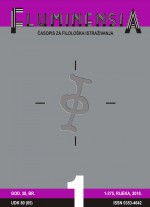TRANSLATION OF ORALITY TRAITS IN LITERARY DIALOGUES
Keywords:
fictive orality, dialogues, translation, German language, Croatian language, English languageAbstract
This paper investigates traits of fictive orality and their translations by studying dialogues from Bernhard Schlink’s novel Der Vorleser and their translations into the Croatian and English language. In the first part of the paper the term fictive orality is explained in the context of classification given by Koch and Oesterreicher (1985), which distinguishes between „the language of immediacy” (“Sprache der Nähe”) which refers to speech, and “the language of distance” (“Sprache der Distanz”) which refers to writing. The ways in which writers create orality in their works, as well as the ways in which it can be recognized in texts, are also represented. In the second part of the paper, selected dialogues from the novel Der Vorleser are analyzed in the source text and in translations.
The analysis of dialogues indicates the presence of the following means for expressing fictive orality: punctuation, exclamations, repetition, and descriptions of nonverbal behaviour. These means refer to spoken communication and characters’ emotions – e.g. punctuation is used to express confusion, insecurity, or hesitation in conversations; exclamations are used to express emotions, tone and mood in the analyzed conversations. Additionally, the analysis of translation strategies reveals that the most frequently utilised translation strategies (as proposed by Baker) are cultural substitution and paraphrase.

